Presbyterianism

| Part of a series on |
| Reformed Christianity |
|---|
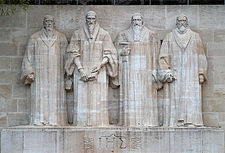 |
|
|
Presbyterianism is a
Presbyterian theology typically emphasizes the sovereignty of God, the
The roots of Presbyterianism lie in the
Presbyterian identity
Early history
Presbyterian tradition, particularly that of the
Development

Presbyterian history is part of the
Presbyterianism was especially influenced by the French theologian
The Presbyterian church traces its ancestry back primarily to Scotland. In August 1560, the
In time, the Scots Confession would be supplanted by the Westminster Confession of Faith, and the larger and shorter catechisms, which were formulated by the Westminster Assembly between 1643 and 1649.
Characteristics
Presbyterians distinguish themselves from other denominations by
Presbyterians place great importance upon education and lifelong learning, tempered with the belief that no human action can affect salvation.
Continuous study of the scriptures, theological writings, and understanding and interpretation of church doctrine are embodied in several statements of faith and catechisms formally adopted by various branches of the church, often referred to as "subordinate standards".
Government
Presbyterian government is by councils (still known as courts in some countries, as boards in others) of elders. Teaching and ruling elders are ordained and convene in the lowest council known as a session or consistory responsible for the discipline, nurture, and mission of the local congregation. Teaching elders (pastors or ministers) have responsibility for teaching, worship, and performing sacraments. Pastors or ministers are called by individual congregations. A congregation issues a call for the pastor or minister's service, but this call must be ratified by the local presbytery. The pastor or minister is a teaching elder, and Moderator of the Session, but is not usually a member of the congregation; instead, this person is a member of the Presbytery of which the given church is a member.
Ruling elders are elected by the congregation and ordained to serve with the teaching elders, assuming responsibility for the nurture and leadership of the congregation. Often, especially in larger congregations, the elders delegate the practicalities of buildings, finance, and temporal ministry to the needy in the congregation to a distinct group of officers (sometimes called deacons, which are ordained in some denominations). This group may variously be known as a "Deacon Board", "Board of Deacons" "Diaconate", or "Deacons' Court". These are sometimes known as "presbyters" to the full congregation. Since the 20th century, most denominations allow women to be teaching or ruling elders.
Above the sessions exist presbyteries, which have area responsibilities. These are composed of teaching elders and ruling elders from each of the constituent congregations. The presbytery sends representatives to a broader regional or national assembly, generally known as the
Presbyterian governance is practiced by Presbyterian denominations and also by many other
Doctrine
This section possibly contains original research. (September 2014) |
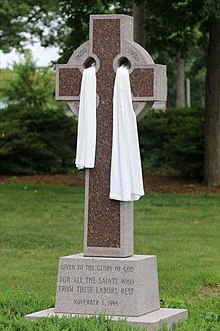


Presbyterianism is historically a confessional tradition. This has two implications. The obvious one is that confessional churches express their faith in the form of "confessions of faith", which have some level of authoritative status. However this is based on a more subtle point: In confessional churches, theology is not solely an individual matter. While individuals are encouraged to understand Scripture, and may challenge the current institutional understanding, theology is carried out by the community as a whole. It is this community understanding of theology that is expressed in confessions.[24]
However, there has arisen a spectrum of approaches to confessionalism. The manner of subscription, or the degree to which the official standards establish the actual doctrine of the church, is a practical matter. That is, the decisions rendered in ordination and in the courts of the church largely determine what the church means, representing the whole, by its adherence to the doctrinal standard.
Some Presbyterian traditions adopt only the
The Westminster Confession is "The principal
The
The Presbyterian Church in Canada developed the confessional document Living Faith (1984) and retains it as a subordinate standard of the denomination. It is confessional in format, yet like the Westminster Confession, draws attention back to original Bible text.
Presbyterians in Ireland who rejected Calvinism and the Westminster Confessions formed the Non-subscribing Presbyterian Church of Ireland.
John Gresham Machen, the prominent Presbyterian theologian and Professor of
Worship and sacraments
Worship
Presbyterian denominations that trace their heritage to the British Isles usually organise their church services inspired by the principles in the

Historically, the driving principle in the development of the standards of Presbyterian worship is the Regulative principle of worship, which specifies that (in worship), what is not commanded is forbidden.[25]
Over subsequent centuries, many Presbyterian churches modified these prescriptions by introducing hymnody, instrumental accompaniment, and ceremonial
Among the

Sacraments
Presbyterians traditionally have held the Worship position that there are only two
- Baptism, in which they baptize infants, as well as unbaptized adults by the Aspersion (sprinkling) or Affusion (pouring) method in the name of the Father and of the Son and of the Holy Spirit, rather than the Immersion method.
- The Lord's Supper (also known as Communion), in which Presbyterians believe in the Real Presence of Christ (pneumatic presence) in the spiritual sense, in the bread and wine through the Holy Spirit, as opposed to being locally present as in transubstantiation or consubstantiation.
Architecture
This section needs additional citations for verification. (January 2024) |
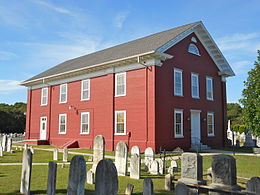
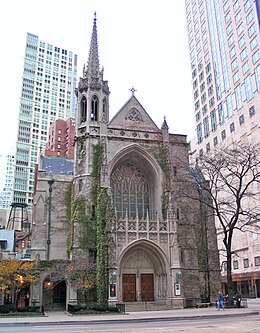
Some early Presbyterians, which were influenced by the puritan movement, were careful to distinguish between the "church", which referred to the members, and the "meeting house", which was the building in which the church met. (Quakers still insist upon this distinction.) Until the late 19th century, very few Presbyterians ever referred to their buildings as "churches". Presbyterians believed that meeting-houses (now called churches) are buildings to support the worship of God. The
In the late 19th century a gradual shift began to occur. Prosperous congregations built imposing churches, such as
While Presbyterian churches historically reflected prevailing architectural trends, the 20th century saw a greater embrace of modern architectural styles, particularly the modernist movement characterized by clean lines, geometric shapes, and open floor plans.[27] Prominent examples include Coral Ridge Presbyterian Church in Fort Lauderdale, Florida, with expansive, light-filled sanctuary and angular design elements. Similarly, the National Presbyterian Church in Washington, D.C., features a striking facade clad in limestone and punctuated by large windows, alongside abstract stained-glass windows. Both of these were designed by famed architect Harold E. Wagoner.

Usually a Presbyterian church will not have statues of saints, nor the ornate altar more typical of a Catholic church. Instead, there is a "communion table", usually on the same level as the congregation, and sometimes elevated similar to an altar, however surrounded by the chancel. There may be a rail between the communion table and the chancel behind it, which may contain a more decorative altar-type table, choir loft, or choir stalls, lectern and clergy area. The altar is called the communion table, and the altar area is called the chancel by Presbyterians. In Presbyterian, and in Reformed churches, there may be an altar cross, either on the communion table or on a table in the chancel. By using the "empty" cross, or cross of the Westminster/Celtic cross, Presbyterians emphasize the resurrection and that Christ is not continually dying, but died once and is alive for all eternity. Quite a few Presbyterian church buildings are decorated with a cross, that has a circle around the center, or Celtic cross. This not only emphasizes the resurrection, but also acknowledges historical aspects of Presbyterianism. A baptismal font will be located either at the entrance or near the chancel area. Presbyterian architecture generally makes significant use of symbolism. One may also find decorative and ornate stained glass windows depicting scenes from the Bible. Some Presbyterian churches will also have ornate statues of Christ or graven scenes from the Last Supper located behind the chancel. St. Giles' Cathedral in Scotland has a crucifix next to an ornate elevated communion table that hangs alongside. The image of Christ is more of a faint image, with a more modern design.[28]
By Region
Europe
Scotland

However, with the
There are now eight Presbyterian denominations in Scotland today. These are, in order of size: the
Within Scotland the term 'kirk' is usually used to refer to a local Presbyterian church. Informally, the term 'The Kirk' refers to the Church of Scotland. Some of the values and ideals espoused in Scottish Presbyterian denominations can be reflected in this reference in a book from Norman Drummond, chaplain to the Queen in Scotland.[29]
Chart of splits and mergers of the Scottish Presbyterian churches
| Splits and mergers of the Scottish Presbyterian churches | |||||||||||||||||||||||||||||||||||||||||||||||||||||||||||||||||||||||||||||||||||||||||||||||||||||||||||||||||||||||||||||||||||||||||||||||||||||||||||||||||||||||||||||||||||||||||||||||||||||||||||||||||||||||||||||||||||||||||||||||||||||||||||||||||||||||||||||||||||||||||||||||||||||||||||||||||||||||||||||||||||||||||||||||||||||||||||||||||||||||||||||||||||||||||||||||||||||||||||||||||||||||||||||||||||||||||||||||||||||||||||||||||||||||||||||||||||||||||||||||||||||||||||||||||||||||||||||||||||||||||||||||||||||||||||||||||||||||||||||||||||||||||||||||||||||||||||||||||||||||||||||||||||||||||||||||||||||||||||||||||||||||||||||||||||||||||||||||||||||||||||||||||||||||||||||||||||||||||||||||||||||||||||||||||||||||||||||||||||||||||||||||||||||||||||||||||||||||||||||||||||||||||||||||||||||||||||||||||||||||||||||||||||||||||||||||||||||||||||||||||||||||||||||||||||||||||||||||||||||||||||||||||||||||||||||||||||||||||||||||||||||||||||||||||||||||||||||||||||||||
|---|---|---|---|---|---|---|---|---|---|---|---|---|---|---|---|---|---|---|---|---|---|---|---|---|---|---|---|---|---|---|---|---|---|---|---|---|---|---|---|---|---|---|---|---|---|---|---|---|---|---|---|---|---|---|---|---|---|---|---|---|---|---|---|---|---|---|---|---|---|---|---|---|---|---|---|---|---|---|---|---|---|---|---|---|---|---|---|---|---|---|---|---|---|---|---|---|---|---|---|---|---|---|---|---|---|---|---|---|---|---|---|---|---|---|---|---|---|---|---|---|---|---|---|---|---|---|---|---|---|---|---|---|---|---|---|---|---|---|---|---|---|---|---|---|---|---|---|---|---|---|---|---|---|---|---|---|---|---|---|---|---|---|---|---|---|---|---|---|---|---|---|---|---|---|---|---|---|---|---|---|---|---|---|---|---|---|---|---|---|---|---|---|---|---|---|---|---|---|---|---|---|---|---|---|---|---|---|---|---|---|---|---|---|---|---|---|---|---|---|---|---|---|---|---|---|---|---|---|---|---|---|---|---|---|---|---|---|---|---|---|---|---|---|---|---|---|---|---|---|---|---|---|---|---|---|---|---|---|---|---|---|---|---|---|---|---|---|---|---|---|---|---|---|---|---|---|---|---|---|---|---|---|---|---|---|---|---|---|---|---|---|---|---|---|---|---|---|---|---|---|---|---|---|---|---|---|---|---|---|---|---|---|---|---|---|---|---|---|---|---|---|---|---|---|---|---|---|---|---|---|---|---|---|---|---|---|---|---|---|---|---|---|---|---|---|---|---|---|---|---|---|---|---|---|---|---|---|---|---|---|---|---|---|---|---|---|---|---|---|---|---|---|---|---|---|---|---|---|---|---|---|---|---|---|---|---|---|---|---|---|---|---|---|---|---|---|---|---|---|---|---|---|---|---|---|---|---|---|---|---|---|---|---|---|---|---|---|---|---|---|---|---|---|---|---|---|---|---|---|---|---|---|---|---|---|---|---|---|---|---|---|---|---|---|---|---|---|---|---|---|---|---|---|---|---|---|---|---|---|---|---|---|---|---|---|---|---|---|---|---|---|---|---|---|---|---|---|---|---|---|---|---|---|---|---|---|---|---|---|---|---|---|---|---|---|---|---|---|---|---|---|---|---|---|---|---|---|---|---|---|---|---|---|---|---|---|---|---|---|---|---|---|---|---|---|---|---|---|---|---|---|---|---|---|---|---|---|---|---|---|---|---|---|---|---|---|---|---|---|---|---|---|---|---|---|---|---|---|---|---|---|---|---|---|---|---|---|---|---|---|---|---|---|---|---|---|---|---|---|---|---|---|---|---|---|---|---|---|---|---|---|---|---|---|---|---|---|---|---|---|---|---|---|---|---|---|---|---|---|---|---|---|---|---|---|---|---|---|---|---|---|---|---|---|---|---|---|---|---|---|---|---|---|---|---|---|---|---|---|---|---|---|---|---|---|---|---|---|---|---|---|---|---|---|---|---|---|---|---|---|---|---|---|---|---|---|---|---|---|---|---|---|---|---|---|---|---|---|---|---|---|---|---|---|---|---|---|---|---|---|---|---|---|---|---|---|---|---|---|---|---|---|---|---|---|---|---|---|---|---|---|---|---|---|---|---|---|---|---|---|---|---|---|---|---|---|---|---|---|---|---|---|---|---|---|---|---|---|---|---|---|---|---|---|---|---|---|---|---|---|---|---|---|---|---|---|---|---|---|---|---|---|---|---|---|---|---|---|---|---|---|---|---|---|---|---|---|---|---|---|---|---|---|---|---|---|---|---|---|---|---|---|---|---|---|---|---|---|---|---|---|---|---|---|---|---|---|---|---|---|---|---|---|---|---|---|---|---|---|---|---|---|---|---|---|---|---|---|---|---|---|---|---|---|---|---|---|---|---|---|---|---|---|---|---|---|---|---|---|---|---|---|---|---|---|---|---|---|---|---|---|---|---|---|---|---|---|---|---|---|---|---|---|---|---|---|---|---|---|---|---|---|---|---|---|---|---|---|---|---|---|---|---|---|---|---|---|---|---|---|---|---|---|---|---|---|---|---|---|---|---|---|---|---|---|---|---|---|---|---|---|---|---|---|---|---|---|---|---|---|---|---|---|---|---|---|---|---|---|---|---|---|---|---|---|---|---|---|---|---|---|---|---|---|---|---|---|---|---|---|---|---|---|---|---|---|---|---|---|---|---|---|---|---|---|---|---|---|---|---|---|---|---|---|---|---|---|---|---|---|---|---|---|---|---|---|---|---|---|
| |||||||||||||||||||||||||||||||||||||||||||||||||||||||||||||||||||||||||||||||||||||||||||||||||||||||||||||||||||||||||||||||||||||||||||||||||||||||||||||||||||||||||||||||||||||||||||||||||||||||||||||||||||||||||||||||||||||||||||||||||||||||||||||||||||||||||||||||||||||||||||||||||||||||||||||||||||||||||||||||||||||||||||||||||||||||||||||||||||||||||||||||||||||||||||||||||||||||||||||||||||||||||||||||||||||||||||||||||||||||||||||||||||||||||||||||||||||||||||||||||||||||||||||||||||||||||||||||||||||||||||||||||||||||||||||||||||||||||||||||||||||||||||||||||||||||||||||||||||||||||||||||||||||||||||||||||||||||||||||||||||||||||||||||||||||||||||||||||||||||||||||||||||||||||||||||||||||||||||||||||||||||||||||||||||||||||||||||||||||||||||||||||||||||||||||||||||||||||||||||||||||||||||||||||||||||||||||||||||||||||||||||||||||||||||||||||||||||||||||||||||||||||||||||||||||||||||||||||||||||||||||||||||||||||||||||||||||||||||||||||||||||||||||||||||||||||||||||||||||||
England
In England, Presbyterianism was established in secret in 1592.
A number of new Presbyterian Churches were founded by Scottish immigrants to England in the 19th century and later. Following the 'Disruption' in 1843 many of those linked to the Church of Scotland eventually joined what became the Presbyterian Church of England in 1876. Some, such as Crown Court (Covent Garden, London), St Andrew's (Stepney, London) and Swallow Street (London), did not join the English denomination, which is why there are Church of Scotland congregations in England such as those at Crown Court, and St Columba's, Pont Street (Knightsbridge) in London. There is also a congregation in the heart of London's financial district called London City Presbyterian Church that is affiliated with the Free Church of Scotland.
In 1972, the Presbyterian Church of England (PCofE) united with the
In recent years a number of smaller denominations adopting Presbyterian forms of church government have organised in England, including the International Presbyterian Church planted by evangelical theologian Francis Schaeffer of the L'Abri Fellowship in the 1970s, and the Evangelical Presbyterian Church in England and Wales founded in the North of England in the late 1980s.
Wales
In
Ireland
Presbyterianism (
France
There is a Church of Scotland (Presbyterian) in central Paris: The Scots Kirk, which is English-speaking, and is attended by many nationalities. It maintains close links with the Church of Scotland in Scotland itself, as well as with the Reformed Church of France.
Italy
The Waldensian Evangelical Church (Chiesa Evangelica Valdese, CEV) is an Italian Protestant denomination. The church was founded in the 12th century, and centuries later, after the Protestant Reformation, it adhered to Calvinist theology and became the Italian branch of the Presbyterian churches. As such, the church is a member of the World Communion of Reformed Churches.
North America
Even before Presbyterianism spread with immigrants abroad from Scotland, there were divisions in the larger Presbyterian family. Some later rejoined only to separate again. In what some interpret as rueful self-reproach, some Presbyterians refer to the divided Presbyterian churches as the "Split Ps".



United States
Presbyterianism first officially arrived in Colonial America in 1644 with the establishment of Christ's First Presbyterian Church in Hempstead, New York. The Church was organized by the Rev. Richard Denton.
In 1703 the first Presbytery in Philadelphia was established. In time, the presbytery would be joined by two more to form a synod (1717) and would evolve into the
Other Presbyterian bodies in the United States include the Reformed Presbyterian Church of North America (RPCNA), the Associate Reformed Presbyterian Church (ARP), the Reformed Presbyterian Church in the United States (RPCUS), the Reformed Presbyterian Church General Assembly, the Reformed Presbyterian Church – Hanover Presbytery, the Covenant Presbyterian Church, the Presbyterian Reformed Church, the Westminster Presbyterian Church in the United States, the Korean American Presbyterian Church, and the Free Presbyterian Church of North America.
The territory within about a 50-mile (80 km) radius of Charlotte, North Carolina, is historically the greatest concentration of Presbyterianism in the Southern United States, while an almost identical geographic area around Pittsburgh, Pennsylvania, contains probably the largest number of Presbyterians in the entire nation.
The PC (USA), beginning with its predecessor bodies, has, in common with other so-called "mainline" Protestant denominations, experienced a significant decline in members in recent years. Some estimates have placed that loss at nearly half in the last forty years.[31]
Presbyterian influence, especially through Princeton theology, can be traced in modern Evangelicalism. Balmer says that:
Evangelicalism itself, I believe, is a quintessentially North American phenomenon, deriving as it did from the confluence of
Puritanism. Evangelicalism picked up the peculiar characteristics from each strain – warmhearted spirituality from the Pietists (for instance), doctrinal precisionism from the Presbyterians, and individualistic introspection from the Puritans – even as the North American context itself has profoundly shaped the various manifestations of evangelicalism: fundamentalism, neo-evangelicalism, the holiness movement, Pentecostalism, the charismatic movement, and various forms of African-American and Hispanic evangelicalism.[32]— Randall Balmer, The Encyclopedia of Evangelicalism (2002)
In the late 1800s, Presbyterian missionaries established a presence in what is now northern New Mexico. This provided an alternative to the Catholicism, which was brought to the area by the Spanish Conquistadors and had remained unchanged. The area experienced a "mini" reformation, in that many converts were made to Presbyterianism, prompting persecution. In some cases, the converts left towns and villages to establish their own neighboring villages. The arrival of the United States to the area prompted the Catholic church to modernize and make efforts at winning the converts back, many of which did return. However, there are still stalwart Presbyterians and Presbyterian churches in the area.
Historically, along with Lutherans and
Canada
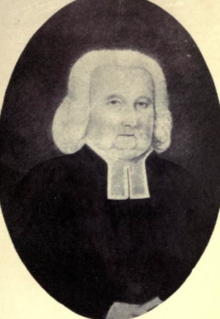
In Canada, the largest Presbyterian denomination – and indeed the largest Protestant denomination – was the
Latin America

Presbyterianism arrived in Latin America in the 19th century.
Mexico
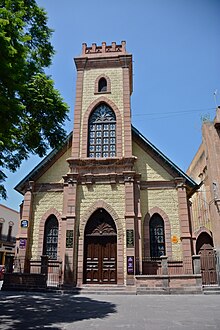
The biggest Presbyterian church is the National Presbyterian Church in Mexico (Iglesia Nacional Presbiteriana de México), which has around 2,500,000 members and associates and 3000 congregations, but there are other small denominations like the Associate Reformed Presbyterian Church in Mexico which was founded in 1875 by the Associate Reformed Church in North America. The Independent Presbyterian Church, the Presbyterian Reformed Church in Mexico, and the National Conservative Presbyterian Church in Mexico are existing churches in the Reformed tradition.
Brazil
In Brazil, the Presbyterian Church of Brazil (Igreja Presbiteriana do Brasil) totals approximately 1,011,300 members;[37] other Presbyterian churches (Independents, United, Conservatives, Renovated, etc.) in this nation have around 350,000 members. The Renewed Presbyterian Church in Brazil was influenced by the charismatic movement and has about 131 000 members as of 2011.[38] The Conservative Presbyterian Church in Brazil was founded in 1940 and has eight presbyteries.[39] The Fundamentalist Presbyterian church in Brazil was influenced by Carl McIntire and the US Bible Presbyterian Church and has around 1 800 members. The Independent Presbyterian Church of Brazil was founded in 1903 by Rev. Eduardo Carlos Pereira, has 500 congregations and 75 000 members. The United Presbyterian Church of Brazil has around 4 000 members. There are also ethnic Korean Presbyterian churches in the country. The Evangelical Reformed Churches in Brazil has Dutch origin. The Reformed Churches in Brazil were recently founded by the Canadian Reformed Churches with the Reformed Churches in the Netherlands (Liberated).
Other Latin American states
There are probably more than four million members of Presbyterian churches in all of Latin America. Presbyterian churches are also present in Peru, Bolivia, Cuba, Trinidad and Tobago, Venezuela, Colombia, Chile, Paraguay, Costa Rica, Nicaragua, Argentina, Honduras and others, but with few members. The Presbyterian Church in Belize has 17 churches and church plants and there is a Reformed Seminary founded in 2004. Some Latin Americans in North America are active in the
Africa

Presbyterianism arrived in Africa in the 19th century through the work of Scottish missionaries and founded churches such as
African Presbyterian churches often incorporate diaconal ministries, including social services, emergency relief, and the operation of mission hospitals. A number of partnerships exist between presbyteries in Africa and the PC(USA), including specific connections with Lesotho, Cameroon, Malawi, South Africa, Ghana and Zambia. For example, the Lackawanna Presbytery, located in Northeastern Pennsylvania, has a partnership with a presbytery in Ghana. Also the Southminster Presbyterian Church, located near Pittsburgh, has partnerships with churches in Malawi and Kenya. The Presbyterian Church of Nigeria, western Africa is also healthy and strong in mostly the southern states of this nation, strong density in the south-eastern states of this country. Beginning from Cross River state, the nearby coastal states, Rivers state, Lagos state to Ebonyi and Abia States. Hope Waddel's missionary expedition in the mid 19th century, and later Mary Slessor's stay in this coastal regions of the then British colony has brought about the beginning and the flourishing of this church in these areas.
Cameroon
The Presbyterian Church in Cameroon currently a member of reformed churches in Cameroon
Kenya
The Presbyterian Church of East Africa, based in Kenya, is particularly strong, with 500 clergy and 4 million members.[41]
Malawi
The Reformed Presbyterian Church in Malawi has 150 congregations and 17 000–20 000 members[citation needed]. It was a mission of the Free Presbyterian church of Scotland. The Restored Reformed Church works with RPCM. Evangelical Presbyterian Church in Malawi is an existing small church. Part of the Presbyterian Church in Malawi and Zambia is known as CCAP, Church of Central Africa-Presbyterian. Often the churches there have one main congregation and a number of prayer houses develop. Education, health ministries, and worship and spiritual development are important.
Southern Africa
Southern Africa is a major base of Reformed and Presbyterian Churches.[citation needed]
Northern Africa
- The Presbyterian Church of South Sudan and Sudan, founded in 1902 by American missionaries in Malakal, was deprived of foreign pastors since 1962 by decision of the Sudanese government but it continued to grow. It is now the 3rd largest Christian church in Sudan with 1,000,000 members, now shared between Sudan and South Sudan.[42]
- The Presbyterian Evangelical Church of Sudan was founded in the north of the country and in Khartoum by the same American missionaries in the late 19th century but left under the guidance of Egyptian evangelical pastors of Coptic origin.[42]
In addition, there are a number of Presbyterian Churches in north Africa, the most known is the Nile Synod in Egypt and a recently founded synod for Sudan.
Asia
Hong Kong
Cumberland Presbyterian Church Yao Dao Secondary School is a Presbyterian school in Yuen Long, New Territories. The Cumberland Presbyterian Church also have a church on the island of Cheung Chau. There are also Korean Christians resident in Hong Kong who are Presbyterians.[citation needed]
South Korea
Presbyterian Churches are the biggest and by far the most influential Protestant denominations in South Korea, with close to 20,000 churches affiliated with the two largest Presbyterian denominations in the country.
Most of the Korean Presbyterian denominations share the same name in Korean, 대한예수교장로회 (literally means the Presbyterian Church of Korea or PCK), tracing its roots to the United Presbyterian Assembly before its long history of disputes and schisms. The Presbyterian schism began with the controversy in relation to the Japanese shrine worship enforced during the Japanese colonial period and the establishment of a minor division (Koryu-pa, 고려파, later The Koshin Presbyterian Church in Korea, Koshin 고신) in 1952. And in 1953 the second schism happened when the theological orientation of the Chosun Seminary (later Hanshin University) founded in 1947 could not be tolerated in the PCK and another minor group (The Presbyterian Church in the Republic of Korea, Kijang, 기장) was separated. The last major schism had to do with the issue of whether the PCK should join the WCC. The controversy divided the PCK into two denominations, The Presbyterian Church of Korea (Tonghap, 통합) and The General Assembly of Presbyterian Church in Korea (Hapdong, 합동) in 1959. All major seminaries associated with each denomination claim heritage from the Pyung Yang Theological Seminary, therefore, not only Presbyterian University and Theological Seminary and Chongsin University which are related to PCK but also Hanshin University of PROK all celebrated the 100th class in 2007, 100 years from the first graduates of Pyung Yang Theological Seminary.[45]
Korean Presbyterian denominations are active in evangelism and many of its missionaries are being sent overseas, being the second biggest missionary sender in the world after the United States. GMS, the missionary body of the "Hapdong" General Assembly of Presbyterian Churches of Korea, is the single largest Presbyterian missionary organization in Korea.[46] In addition there are many Korean-American Presbyterians in the United States, either with their own church sites or sharing space in pre-existing churches as is the case in Australia, New Zealand and even Muslim countries such as Saudi Arabia with Korean immigration.
The Korean Presbyterian Church started through the mission of the Presbyterian Church (USA) and the Australian Presbyterian theological tradition is central to the United States. But after independence, the 'Presbyterian Church in Korea (KoRyuPa)' advocated a Dutch
Taiwan
The
India
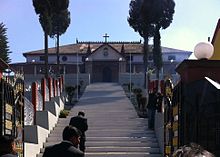
In the mainly Christian Indian state of
Oceania
Australia

In Australia, Presbyterianism is the fourth largest denomination of Christianity, with nearly 600,000 Australians claiming to be Presbyterian in the 2006 Commonwealth Census. Presbyterian churches were founded in each colony, some with links to the Church of Scotland and others to the Free Church. There were also congregations originating from United Presbyterian Church of Scotland as well as a number founded by John Dunmore Lang. Most of these bodies merged between 1859 and 1870, and in 1901 formed a federal union called the Presbyterian Church of Australia but retaining their state assemblies. The Presbyterian Church of Eastern Australia representing the Free Church of Scotland tradition, and congregations in Victoria of the Reformed Presbyterian Church, originally from Ireland, are the other existing denominations dating from colonial times.
In 1977, about 70% of the Presbyterian Church of Australia, along with most of the Congregational Union of Australia and all the Methodist Church of Australasia, combined to form the Uniting Church in Australia.[47] The 30% who did not unite had various reasons for so acting, often cultural attachment but often conservative theological or social views. The permission for the ordination of women given in 1974 was rescinded in 1991 without affecting the two or three existing woman ministers[citation needed]. The approval of women elders given in the 1960s has been rescinded in all states except New South Wales, which has the largest membership[citation needed]. The theology of the church is now generally conservative and Reformed[citation needed]. A number of small Presbyterian denominations have arisen since the 1950s through migration or schism.
New Zealand
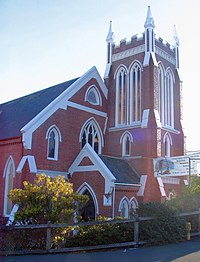
In
Originally there were two branches of Presbyterianism in New Zealand, the northern Presbyterian church which existed in the North Island and the parts of the South Island north of the Waitaki River, and the Synod of Otago and Southland, founded by Free Church settlers in southern South Island. The two churches merged in 1901, forming what is now the Presbyterian Church of Aotearoa New Zealand.
In addition to the Presbyterian Church of Aotearoa New Zealand, there is also a more conservative Presbyterian church called Grace Presbyterian Church of New Zealand. Many of its members left the largely liberal PCANZ because they were seeking a more conservative church. It has 17 churches throughout New Zealand.
Vanuatu
The
See also
- Celtic cross
- English Presbyterianism
- Fundamentalist–Modernist Controversy
- Ghost Ranch
- Puritan's Pit
- Presbyterian confessions of faith
- Religion in Scotland
- Category:Presbyterian universities and colleges
- Category:Presbyterians
Churches
- List of Christian denominations#Presbyterianism
- List of Presbyterian churches
- St Giles' Cathedral, Edinburgh (Church of Scotland) – famous among Presbyterians worldwide for John Knox's success in preaching there
References
- ^ "Burning Bush | Presbyterian Church Ireland". Archived from the original on 18 June 2013. Retrieved 16 June 2013.
- ^ "What Is Presbyterianism?". Ligonier Ministries. Retrieved 27 February 2024.
- ISBN 978-0-300-10507-0.
- ^ "Protestant Religion and Presbyterian Church Act 1707". The National Archives. United Kingdom. Archived from the original on 21 August 2019. Retrieved 19 October 2011.
- ^ "Who Are Presbyterians and What Do They Believe?". Learn Religions. Archived from the original on 8 July 2020. Retrieved 14 September 2020.
- ISBN 978-1-63087-878-8. Archivedfrom the original on 29 April 2016. Retrieved 19 February 2016.
- ^ ISBN 978-1-5261-0023-8.
For many Presbyterian evangelicals in Scotland, the 'achievements of the Reformation represented the return to a native or national tradition, the rejection of an alien tyranny that had suppressed ... Scotland's true character as a Presbyterian nation enjoying the benefits of civil and religious liberty'. What they had in mind was the mission established by Columba at Iona and the subsequent spread of Christianity through the Culdees of the seventh to eleventh centuries. For Presbyterian scholars in the nineteenth century, these communities of clergy who differed in organisation and ethos from later monastic orders were further evidence of the similarity between early Christianity in Ireland and Scotland and later Presbyterianism. This interpretation of the character of the Celtic Church was an important aspect of Presbyterian identity in global terms. At the first meeting in 1877 of the Alliance of the Reformed Churches holding the Presbyterian System (later the World Alliance of Reformed Churches), Peter Lorimer (1812–79), a Presbyterian professor in London, noted 'that the early Church of St. Patrick, Columba, and Columbanus, was far more nearly allied in its fundamental principles of order and discipline to the Presbyterian than to the Episcopalian Churches of modern times'.
- ^ Taylor, James; Anderson, John (1852). The Pictorial History of Scotland. p. 51.
The zealous Presbyterian maintains, that the church established by Columba was formed on a Presbyterian model, and that it recognized the great principle of clerical equality.
- ISBN 978-1-84952-272-4.
Columba has found favour with enthusiasts for all things Celtic and with those who have seen him as establishing a proto-Presbyterian church clearly distinguishable from the episcopally governed church favoured by Rome-educated Bishop Ninian.
- ^ Dickens-Lewis, W.F. (1920). "Apostolicity of Presbyterianism: Ancient Culdeeism and Modern Presbyterianism". The Presbyterian Magazine. 26 (1–7). Presbyterian Church (USA): 529.
The Culdees who claimed at the Synod of Whitby apostolic descent from St. John, as against the Romish claim of the authority of St. Peter, retired into Scotland.
- ^ Thomson, Thomas (1896). A History of the Scottish People from the Earliest Times. Blackie. p. 141.
...for the primitive apostolic church which St. John had established in the East and Columba transported to our shores. Thus the days of Culdeeism were numbered, and she was now awaiting the martyrs doom.
- ^ Mackay, John; Mackay, Annie Maclean Sharp (1902). The Celtic Monthly. Archibald Sinclair. p. 236.
- ISBN 978-1-137-30635-7.
Presbyterians after 1690 gave yet more play to 'Culdeeism', a reading of the past wherein 'culdees' (derived from céli dé) were presented as upholding a native, collegiate, proto presbyterian church government uncontaminated by bishops.
- ^ Rankin, James (1884). The Young Churchman: lessons on the Creed, the Commandments, the means of grace, and the Church. William Blackwood and Sons. p. 84.
For seven whole centuries (400–1100 A.D.) there existed in Scotland a genuine Celtic Church, apparently of Greek origin, and in close connection with both Ireland and Wales. In this Celtic Church no Pope was recognized, and no prelatical of diocesan bishops existed. Their bishops were of the primitive New Testament style—presbyter-bishops. Easter was kept at a different time from that of Rome. The tonsure of the monks was not, like that of Rome, on the crown, but across the forehead from ear to ear. The monastic system of the Celtic Church was extremely simple—small communities of twelve men were presided over by an abbot (kindred to the Patriarch title of the Greeks), who took precedence of the humble parochial bishops.
- ^ ISBN 978-1-4556-0866-9.
The Celtic Church evolved separated from the Roman Catholic Church. The Celtic Church was primarily monastic, and the monasteries were administered by an abbot. Not as organized as the church in Rome, it was a much looser institution. The Celtic Church celebrated Easter on a different date from the Roman, too. Life within the Celtic Church tended to be ascetic. Education was an important element, as was passion for spreading the word, that is, evangelism. The Celtic brothers led a simple life in simply constructed buildings. The churches and monastic buildings were usually made of wood and wattle and had thatched roofs. After the death of St. Columba in A.D. 597, the autonomy of the Celtic Church did not last long. The Synod of Whitby in 664 decided, once and for all, that Easter would be celebrated according to the Roman date, not the Celtic date. This was the beginning of the end for the Celtic Church.
- ISBN 978-0-7509-6475-3.
After the Synod of Whitby in about 664, the Roman tradition was imposed on the whole Church, though remnants of the Celtic tradition lingered in practice.
- ISBN 978-0-19-522393-4.
A distinctive part of Scottish Presbyterian worship is the singing of metrical psalms, many of them set to old Celtic Christianity Scottish traditional and folk tunes. These verse psalms have been exported to Africa, North America and other parts of the world where Presbyterian Scots missionaries or Emigres have been influential.
- ISBN 978-1-4128-2645-7.
Last, because Scotland was a sovereign land in the sixteenth century, the Scottish Reformation came under the influence of John Knox rather than Henry Tudor. The organization of the Church of Scotland became Presbyterian, with significant Calvinist influences, rather than Episcopalian. Upon incorporation Scotland was allowed to keep her church intact. These regional religious differences were to an extent superimposed upon linguistic differences in Wales, Scotland, and Ireland. One of the legacies of the Celtic social organization was the persistence of the Celtic languages Gaelic and Welsh among certain groups in the periphery.
- ^ Kang, Min (2011). John Calvin and John a Lasco on Church Order. pp. 6, 44.
- ^ "Established Church of Scotland". Catholic Encyclopedia. Archived from the original on 20 November 2018. Retrieved 26 September 2010.
- ^ "Church of Scotland – Historical Records". 22 February 2010. Archived from the original on 6 May 2019. Retrieved 31 May 2016.
- ^ Constitution of the Presbyterian Church (USA): Part I: The Book of Confessions, p. 267.
- ^ "Available Emblems of Belief for Placement on Government Headstones and Markers". United States Department of Veterans Affairs. Archived from the original on 4 May 2019. Retrieved 22 March 2015.
- ^ D. G. Hart, "The Lost Soul of American Protestantism." Rowman and Littlefield, 2004[page needed]
- ^ Westminster Confession of Faith, Chapter XXI, paragraph I
- ISBN 978-0-7190-0794-1.
Following the formulation of the Westminster Confession, fully fledged Sabbatarianism quickly took root too, being embodied in an Act of 1661, then spreading northwards and westwards as the Highlands were opened up after the '45, during which time the doctrine lost its original force and vigour in the Lowlands.
- ^ "What Is Modern Architecture? Everything You Ever Wanted to Know". The Spruce. Retrieved 27 February 2024.
- ^ "Cathedral Life". 24 September 2018. Archived from the original on 6 August 2020. Retrieved 29 July 2020.
- ISBN 978-0-340-97991-4.
- ^ Kiprop, Victor (16 April 2019). "Religion Demographics Of Northern Ireland". www.worldatlas.com. World Facts. Retrieved 2 September 2021.
- ^ "Big Losses Projected", News, Layman, 2006, archived from the original on 5 July 2008.
- ISBN 978-0-664-22409-7. Archivedfrom the original on 6 September 2015. Retrieved 27 June 2015.
- ^ Ayres, B. Drummond Jr. (28 April 1981). "The Episcopalians: An American Elite with Roots Going Back to Jamestown". New York Times. Archived from the original on 19 January 2018. Retrieved 17 August 2012.
- ^ Irving Lewis Allen, "WASP—From Sociological Concept to Epithet", Ethnicity, 1975 154+
- S2CID 146933599.
- ^ Baltzell (1964). The Protestant Establishment. New York, Random House. p. 9.
- ^ "Estatísticas 2011 Dados Estimados" (PDF). Executivaipb.com.br. Archived (PDF) from the original on 24 September 2015. Retrieved 30 January 2018.
- ^ "Igreja Presbiteriana Renovada do Brasil". IPRB. Archived from the original on 1 November 2016. Retrieved 25 May 2013.
- ^ "Igreja Presbiteriana Conservadora do Brasil". IPCB. Archived from the original on 21 May 2013. Retrieved 25 May 2013.
- ^ "Worldwide Ministries, Africa". PC(USA). Archived from the original on 15 August 2013. Retrieved 7 December 2012.
- ^ "Worldwide Ministries, Kenya". PC(USA). Archived from the original on 15 August 2013. Retrieved 7 December 2012.
- ^ a b "Presbyterian Church of South Sudan and Sudan". the website of the World Council of Churches. January 1965. Archived from the original on 18 November 2018. Retrieved 14 September 2018..
- ^ "History". KR: The Presbyterian Church of Korea. Archived from the original on 18 July 2011. Retrieved 1 August 2011..
- ^ "Touched by Devotion in South Korea" (article). Christian Reformed Church. 4 October 2010. Archived from the original on 9 July 2017. Retrieved 4 September 2013..
- ^ 리폼드뉴스 (in Korean). KR: Reformed news. 28 May 2009. Archived from the original on 22 July 2011. Retrieved 7 August 2011.
- ^ Search, KR: KCM, archived from the original on 29 October 2013, retrieved 7 August 2011.
- ^ Rowland Ward and Robert Humphreys, Religious Bodies in Australia, 3rd edition (Wantirna, Victoria: New Melbourne Press, 1995), 77.
Sources
- Stewart J Brown. The National Churches of England, Ireland, and Scotland, 1801–46 (2001)
- William the Baptist by James M. Chaney (Reformed Presbyterian perspective on baptism and infant baptism)
- Jay E. Adams. The Meaning and Mode of Baptism Thomas Shepard. (1975) (Reformed Presbyterian perspective on Aspersion and Affusion)
- The Church Membership of Children, and Their Right to Baptism Archived 11 November 2011 at the Wayback Machine (1662) (Reformed Presbyterian perspective on infants' right to church membership)
- William Henry Foote. Sketches of North Carolina, Historical and Biographical...(1846) Archived 4 February 2008 at the Wayback Machine – full-text history of early North Carolina and its Presbyterian churches
- Andrew Lang (1905). John Knox and the Reformation. Longmans, Green, and Company.
- William Klempa, ed. The Burning Bush and a Few Acres of Snow: The Presbyterian Contribution to Canadian Life and Culture (1994)
- Marsden, George M. The Evangelical Mind and the New School Presbyterian Experience (1970)
- Mark A Noll. Princeton And The Republic, 1768–1822 (2004)
- Frank Joseph Smith, The History of the Presbyterian Church in America, Reformation Education Foundation, Manassas, VA 1985
- William Warren Sweet, Religion on the American Frontier, 1783—1840, vol. 2, The Presbyterians (1936), primary sources
- Ernest Trice Thompson. Presbyterians in the South vol 1: to 1860; Vol 2: 1861–1890; Vol 3: 1890–1972. (1963–1973)
- Leonard J. Trinterud, The Forming of an American Tradition: A Re-examination of Colonial Presbyterianism (1949)
- Encyclopedia of the Presbyterian Church in the United States of America (1884)
- St.Andrews Prebystarian church in Lahore, Pakistan.Church Website Archived 1 April 2020 at the Wayback Machine
- "Presbyterian 101 – Mission and Ministry – GAMC". Pcusa.org. Archived from the original on 2 September 2009. Retrieved 7 August 2011.
- "History and Architecture :: East Liberty Presbyterian Church, Pittsburgh, PA :: "The Cathedral of Hope"". Cathedralofhope.org. Archived from the original on 25 July 2011. Retrieved 7 August 2011.
Further reading
- Davies, A. Mervyn (1965). Presbyterian Heritage.
- Feldmeth, Nathan P.; Fortson, S. Donald III; Rosell, Garth M.; Stewart, Kenneth J. (2022). Reformed and Evangelical across Four Centuries: The Presbyterian Story in America. Grand Rapids, MI: Eerdmans.
- Lingle, Walter L.; Kuykendall, John W. (1978). Presbyterians: Their History and Beliefs (4th rev. ed.). Atlanta: Westminster John Knox Press.
- Smylie, James H. (1996). A Brief History of the Presbyterians. Louisville, KY: Geneva Press. ISBN 978-0-664-50001-6.
External links
 Media related to Presbyterianism at Wikimedia Commons
Media related to Presbyterianism at Wikimedia Commons- Presbyterian Heritage and History Center
- Presbyterian & Reformed Publishing
